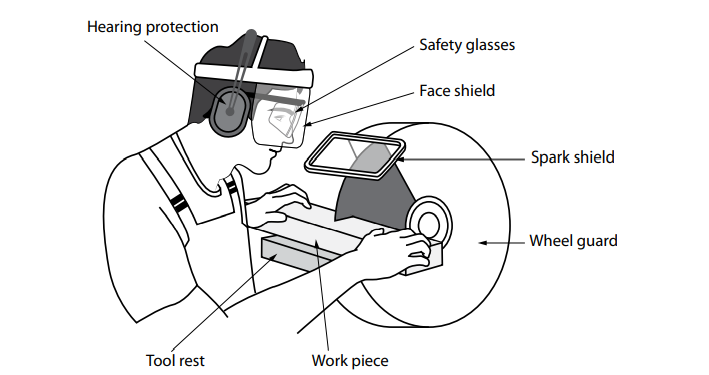LEARNING TASK 4 : Describe general safety precautions and procedures
Tools
You must think about safety before using any tool. You should know how the tool works and some of the possible dangers of using it incorrectly.
Make sure every tool you use is in good condition.
Report any tool or piece of equipment that is broken or does not function properly to your immediate supervisor or tool crib attendant. Also tag the equipment and remove it from service for repair or disposal.
Proper tool use
Only use tools for their intended function. Make sure the tool is the right size for the job. Do not modify or adapt a tool in a manner that might make it unsafe. Do not use power tools that haven’t been tested and certified for use in Canada. Power tools must have a Canadian testing certification label (CSA, ULC).
General hand tool safety
There are a number of general safety rules that you must follow when you use hand tools:
- Keep tools clean and in good working order. Wipe them with a light oil to prevent rusting.
- Never leave tools where they protrude or can fall and strike someone, particularly in an area where work is being done above ground level.
- Return tools to their proper place when not in use.
- Always wear safety goggles or a face shield to protect your eyes when using hand tools that may produce flying chips or particles, such as chisels and hammers.
- When using a sharp-edged tool, always cut away from the body.
- Make sure that all handles on tools (such as axes and hammers) are tight-fitting and adequately secured.
- Keep edge-cutting tools properly sharpened so that they do the job well and do not have to be forced because of dull edges.
General power tool safety
Extreme care should be taken when operating power tools and equipment. Before you attempt to operate any tool or piece of equipment, you must be fully trained by an experienced operator. Make sure that all guards are in place and function properly, and that all electrical connections are properly made.
Observe the following precautions when using equipment:
- Understand the correct operating procedures and safety precautions before operating a piece of equipment.
- Ensure the tools are double insulated and properly grounded.
- Report defective or unsafe equipment to a responsible individual to prevent serious injury.
- Do not distract or interfere with the operator of a machine.
- Ensure cords to electrically powered tools are in good condition, with no frayed parts or bare wires showing.
- Make sure all guards on tools such as saws and grinders are in place, function properly, and are not wedged open.
- Always keep long hair and beards confined and clothing snug to avoid snagging.
Make sure that hand and power tools are inspected, serviced, repaired, sharpened, or dressed as required to make them safe for use. Before using any tool, check the condition of all guards, tool retainers, power supply cords, extension cords, and other accessories. It is an unsafe practice to bypass, disconnect, or remove guards, hoods, or shields. Report any damage or defects and return the tool to the crib for tagout. Always use the appropriate safety equipment to protect your eyes and face from flying particles during any drilling, grinding, or buffing operations with an electric or pneumatic power tool (Figure 3).

Be sure the equipment or machine is free from obstruction and that all personnel are clear before the machinery is activated. Hold hand-held power tools firmly and with adequate control and assume a comfortable, balanced body position.
Possible injury comes from the functional or “working” part of the tool, which could be the drill, blade, disk, grinding wheel, or other device. Shut off machinery if you are leaving the immediate area. Always disconnect, unplug, or lock out equipment before changing saw blades or grinding wheels, and before making major adjustments or performing preventive maintenance.
Allow revolving machinery to stop on its own before leaving it. Do not slow down or stop a machine with your hands. Before you begin adjusting or cleaning any machine, make sure it is stopped and LOTO or disconnected from the power source.
Some power tools have arbors (shafts or spindles) for mounting grinding wheels or other rotating tools. Always check to see that the wheel, blade, or other rotating tool is securely mounted on the arbor.
The importance of using power tools safely cannot be overemphasized. The two general types of power tools that you will use are electrical and pneumatically powered tools.
Do not lift or move an electric tool by its power supply cord. Supply cords are easily damaged and malfunctions can result from improper handling. Always remove plugs by grasping the plug and pulling it straight out of the wall receptacle.
Portable pneumatic (air-powered) tools present some of the same hazards as electrically powered tools, plus some that are unique to pneumatic tools. For example, you can trip over air supply hoses just as you can trip over electric tool cords. If an air hose is cut, broken, or disconnected while under pressure, it can whip about and strike or injure someone.
Route air hoses overhead or out of the way so they are not a tripping hazard; do not allow them to lie where they may be cut or run over by vehicles. The air blowing free from a hose can also cause chips, dirt and debris to fly about, causing irritating or dangerous conditions for the eyes and lungs.
Never point an air tool (e.g., an air chisel) in the direction of another person, as the tool may fly out and strike them. Never use compressed air to clean your clothing or blow air at any part of your body or another person. Air penetrating your skin can enter your bloodstream and cause death.

